
George Bentham was an English botanist, described by the weed botanist Duane Isely as "the premier systematic botanist of the nineteenth century". Born into a distinguished family, he initially studied law, but had a fascination with botany from an early age, which he soon pursued, becoming president of the Linnaean Society in 1861, and a fellow of the Royal Society in 1862. He was the author of a number of important botanical works, particularly flora. He is best known for his taxonomic classification of plants in collaboration with Joseph Dalton Hooker, his Genera Plantarum (1862–1883). He died in London in 1884.

Sir William Jackson Hooker was an English botanist and botanical illustrator, who became the first director of Kew when in 1841 it was recommended to be placed under state ownership as a botanic garden. At Kew he founded the Herbarium and enlarged the gardens and arboretum. The standard author abbreviation Hook. is used to indicate this person as the author when citing a botanical name.

GastoniaCommerson ex Lamarck is a formerly accepted genus of plants in the ivy and ginseng family, Araliaceae. It had been known as an unnatural group, but was recognized as late as 2010, when its nine species were distributed to four different subgenera of the large genus Polyscias. Because the genus Gastonia is now obsolete, its species are herein referred to by their names in Polyscias.
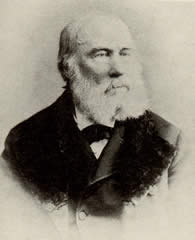
Walter Hood Fitch was a botanical illustrator, born in Glasgow, Scotland, who executed some 10,000 drawings for various publications. His work in colour lithograph, including 2700 illustrations for Curtis's Botanical Magazine, produced up to 200 plates per year.

Manilkara is a genus of trees in the family Sapotaceae. They are widespread in tropical and semitropical locations, in Africa, Madagascar, Asia, Australia, and Latin America, as well as various islands in the Pacific and in the Caribbean. A close relative is the genus Pouteria.

Luina, commonly called silverback, is a small genus of perennial shrubs in the groundsel tribe within the sunflower family.

Sphyranthera is a plant genus of the family Euphorbiaceae and the only genus of its tribe (Sphyranthereae). It was first described in 1887. The entire genus is endemic to the Andaman & Nicobar Islands in the Bay of Bengal, politically part of India but geographically closer to Myanmar.
- Sphyranthera airyshawiiChakrab. & Vasudeva Rao - N Andaman Islands
- Sphyranthera lutescens(Kurz) Pax & K.Hoffm. - N Nicobar Islands + C Andaman Islands
Lasiococca is a plant genus of the family Euphorbiaceae first described in 1887. These are small to relatively large trees found in scrubs or semi-evergreen forests. They grow in India, Indochina, Southeast Asia, and southern China.
- Lasiococca brevipes(Merr.) Welzen & S.E.C.Sierra - Peninsular Malaysia, Philippines, Lesser Sunda Islands, Sulawesi
- Lasiococca chaniiThin - Vietnam
- Lasiococca comberiHaines - Hainan, Yunnan, Vietnam, Thailand, E India
- Lasiococca lociiThin - Vietnam
- Lasiococca symphylliifolia(Kurz) Hook.f. - Sikkim
Megistostigma is a genus of plant of the family Euphorbiaceae first described as a genus in 1887. It is native to southern China, Assam, and Southeast Asia.
- Megistostigma burmanicum - Assam, Myanmar, Thailand, Perlis
- Megistostigma cordatum - Sumatra, Sabah, Samar
- Megistostigma glabratum - Peninsular Malaysia, Anamba Islands, N Sumatra
- Megistostigma peltatum - Siberut, Natuna, Java
- Megistostigma yunnanense - Yunnan
Maesobotrya is a genus of flowering plant belonging to the family Phyllanthaceae first described as a genus in 1879. It is native to sub-Saharan Africa. It is dioecious, with male and female flowers on separate plants.

Peridiscaceae is a family of flowering plants in the order Saxifragales. Four genera comprise this family: Medusandra, Soyauxia, Peridiscus, and Whittonia., with a total of 12 known species. It has a disjunct distribution, with Peridiscus occurring in Venezuela and northern Brazil, Whittonia in Guyana, Medusandra in Cameroon, and Soyauxia in tropical West Africa. Whittonia is possibly extinct, being known from only one specimen collected below Kaieteur Falls in Guyana. In 2006, archeologists attempted to rediscover it, however, it proved unsuccessful.
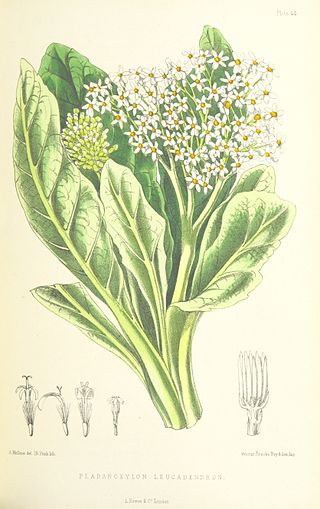
Pladaroxylon is a genus of trees in the tribe Senecioneae within the family Asteraceae.
Soyauxia is a genus of flowering plants in the family Peridiscaceae. They are small trees or erect shrubs from wet forests of tropical West Africa. Eight specific names have been published in Soyauxia. Additional species have been discovered, but their names and descriptions will not be published until 2009 or 2010. The type species for the genus is Soyauxia gabonensis.
Limnopoa is a genus of Indian plants in the grass family. The only known species is Limnopoa meeboldii, native to the State of Kerala in southern India.
Lophacme is a genus of African plants in the grass family.
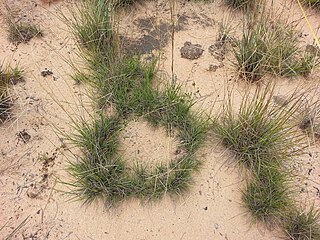
Craspedorhachis is a genus of African plants in the grass family.
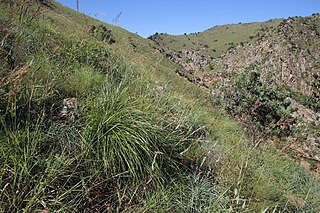
Diheteropogon is a genus of African plants in the grass family.
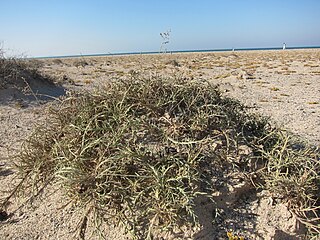
Odyssea is a genus of African and Arabian plants in the grass family.
Lygisma is a plant genus in the family Apocynaceae, first described as a genus in 1883. It is native to southern China, Indochina, Malaysia, and the Himalayas.
- Lygisma angustifolia(Wight) Hook.f. - Himalayas
- Lygisma flavum(Ridl.) Kerr - Peninsular Malaysia
- Lygisma inflexum(Costantin) Kerr - Vietnam, Guangdong, Guangxi, Hainan
- Lygisma nervosumKerr - Thailand

Thurnia is a group of herbaceous plants described as a genus in 1883.













